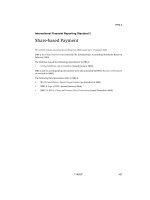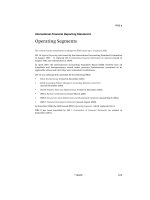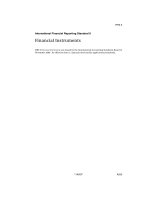Tài liệu Báo cáo tài chính quốc tế 6 ppt
Bạn đang xem bản rút gọn của tài liệu. Xem và tải ngay bản đầy đủ của tài liệu tại đây (160.85 KB, 30 trang )
IFRS 6
©
IASCF 717
International Financial Reporting Standard 6
Exploration for and Evaluation of
Mineral Resources
This version includes amendments resulting from IFRSs issued up to 17 January 2008.
IFRS 6 Exploration for and Evaluation of Mineral Resources was issued by the International
Accounting Standards Board in December 2004.
IFRS 6 and its accompanying documents have been amended by the following IFRSs:
• Amendments to IFRS 1 and IFRS 6 (issued June 2005)
•IFRS 8 Operating Segments (issued November 2006)
•IAS 1 Presentation of Financial Statements (as revised in September 2007).
IFRS 6
718
©
IASCF
C
ONTENTS
paragraphs
INTRODUCTION IN1–IN5
INTERNATIONAL FINANCIAL REPORTING STANDARD 6
EXPLORATION FOR AND EVALUATION OF
MINERAL RESOURCES
OBJECTIVE 1–2
SCOPE 3–5
RECOGNITION OF EXPLORATION AND EVALUATION ASSETS 6–7
Temporary exemption from IAS 8 paragraphs 11 and 12 6–7
MEASUREMENT OF EXPLORATION AND EVALUATION ASSETS 8–14
Measurement at recognition 8
Elements of cost of exploration and evaluation assets 9–11
Measurement after recognition 12
Changes in accounting policies 13–14
PRESENTATION 15–17
Classification of exploration and evaluation assets 15–16
Reclassification of exploration and evaluation assets 17
IMPAIRMENT 18–22
Recognition and measurement 18–20
Specifying the level at which exploration and evaluation assets are assessed
for impairment 21–22
DISCLOSURE 23–25
EFFECTIVE DATE 26
TRANSITIONAL PROVISIONS 27
APPENDICES
A Defined terms
B Amendments to other IFRSs
APPROVAL OF IFRS 6 BY THE BOARD
APPROVAL OF AMENDMENTS TO IFRS 1 AND IFRS 6 BY THE BOARD
BASIS FOR CONCLUSIONS
DISSENTING OPINIONS
IFRS 6
©
IASCF 719
International Financial Reporting Standard 6 Exploration for and Evaluation of Mineral
Resources (IFRS 6) is set out in paragraphs 1–27 and Appendices A and B. All the
paragraphs have equal authority. Paragraphs in
bold type
state the main principles.
Terms defined in Appendix A are in italics the first time they appear in the Standard.
Definitions of other terms are given in the Glossary for International Financial
Reporting Standards. IFRS 6 should be read in the context of its objective and the Basis
for Conclusions, the Preface to International Financial Reporting Standards and the Framework
for the Preparation and Presentation of Financial Statements. IAS 8 Accounting Policies, Changes
in Accounting Estimates and Errors provides a basis for selecting and applying accounting
policies in the absence of explicit guidance .
IFRS 6
720
©
IASCF
Introduction
Reasons for issuing the IFRS
IN1 The International Accounting Standards Board decided to develop an
International Financial Reporting Standard (IFRS) on exploration for and
evaluation of mineral resources because:
(a) until now there has been no IFRS that specifically addresses the accounting
for those activities and they are excluded from the scope of IAS 38 Intangible
Assets. In addition, ‘mineral rights and mineral resources such as oil,
natural gas and similar non-regenerative resources’ are excluded from the
scope of IAS 16 Property, Plant and Equipment. Consequently, an entity was
required to determine its accounting policy for the exploration for and
evaluation of mineral resources in accordance with paragraphs 10–12 of
IAS 8 Accounting Policies, Changes in Accounting Estimates and Errors.
(b) there are different views on how exploration and evaluation expenditures
should be accounted for in accordance with IFRSs.
(c) accounting practices for exploration and evaluation assets under the
requirements of other standard-setting bodies are diverse and often differ
from practices in other sectors for expenditures that may be considered
analogous (eg accounting practices for research and development costs in
accordance with IAS 38).
(d) exploration and evaluation expenditures are significant to entities engaged
in extractive activities.
(e) an increasing number of entities incurring exploration and evaluation
expenditures present their financial statements in accordance with IFRSs,
and many more are expected to do so from 2005.
IN2 The Board’s predecessor organisation, the International Accounting Standards
Committee, established a Steering Committee in 1998 to carry out initial work on
accounting and financial reporting by entities engaged in extractive activities.
In November 2000 the Steering Committee published an Issues Paper Extractive
Industries.
IN3 In July 2001 the Board announced that it would restart the project only when
agenda time permitted. Although the Board recognised the importance of
accounting for extractive activities generally, it decided in September 2002 that
it was not feasible to complete the detailed analysis required for this project,
obtain appropriate input from constituents and undertake the Board’s normal
due process in time to implement changes before many entities adopted IFRSs
in 2005.
IN4 The Board’s objectives for this phase of its extractive activities project are:
(a) to make limited improvements to accounting practices for exploration and
evaluation expenditures, without requiring major changes that might be
reversed when the Board undertakes a comprehensive review of accounting
IFRS 6
©
IASCF 721
practices used by entities engaged in the exploration for and evaluation of
mineral resources.
(b) to specify the circumstances in which entities that recognise exploration
and evaluation assets should test such assets for impairment in accordance
with IAS 36 Impairment of Assets.
(c) to require entities engaged in the exploration for and evaluation of mineral
resources to disclose information about exploration and evaluation assets,
the level at which such assets are assessed for impairment and any
impairment losses recognised.
Main features of the IFRS
IN5 The IFRS:
(a) permits an entity to develop an accounting policy for exploration and
evaluation assets without specifically considering the requirements of
paragraphs 11 and 12 of IAS 8. Thus, an entity adopting IFRS 6 may
continue to use the accounting policies applied immediately before
adopting the IFRS. This includes continuing to use recognition and
measurement practices that are part of those accounting policies.
(b) requires entities recognising exploration and evaluation assets to perform
an impairment test on those assets when facts and circumstances suggest
that the carrying amount of the assets may exceed their recoverable
amount.
(c) varies the recognition of impairment from that in IAS 36 but measures the
impairment in accordance with that Standard once the impairment is
identified.
IFRS 6
722
©
IASCF
International Financial Reporting Standard 6
Exploration for and Evaluation of Mineral Resources
Objective
1 The objective of this IFRS is to specify the financial reporting for the exploration for
and evaluation of mineral resources.
2 In particular, the IFRS requires:
(a) limited improvements to existing accounting practices for exploration and
evaluation expenditures.
(b) entities that recognise exploration and evaluation assets to assess such assets
for impairment in accordance with this IFRS and measure any impairment
in accordance with IAS 36 Impairment of Assets.
(c) disclosures that identify and explain the amounts in the entity’s financial
statements arising from the exploration for and evaluation of mineral
resources and help users of those financial statements understand the
amount, timing and certainty of future cash flows from any exploration
and evaluation assets recognised.
Scope
3 An entity shall apply the IFRS to exploration and evaluation expenditures that it
incurs.
4 The IFRS does not address other aspects of accounting by entities engaged in the
exploration for and evaluation of mineral resources.
5 An entity shall not apply the IFRS to expenditures incurred:
(a) before the exploration for and evaluation of mineral resources, such as
expenditures incurred before the entity has obtained the legal rights to
explore a specific area.
(b) after the technical feasibility and commercial viability of extracting a
mineral resource are demonstrable.
Recognition of exploration and evaluation assets
Temporary exemption from IAS 8 paragraphs 11 and 12
6 When developing its accounting policies, an entity recognising exploration and
evaluation assets shall apply paragraph 10 of IAS 8 Accounting Policies, Changes in
Accounting Estimates and Errors.
IFRS 6
©
IASCF 723
7 Paragraphs 11 and 12 of IAS 8 specify sources of authoritative requirements and
guidance that management is required to consider in developing an accounting
policy for an item if no IFRS applies specifically to that item. Subject to
paragraphs 9 and 10 below, this IFRS exempts an entity from applying those
paragraphs to its accounting policies for the recognition and measurement of
exploration and evaluation assets.
Measurement of exploration and evaluation assets
Measurement at recognition
8 Exploration and evaluation assets shall be measured at cost.
Elements of cost of exploration and evaluation assets
9 An entity shall determine an accounting policy specifying which expenditures are
recognised as exploration and evaluation assets and apply the policy consistently.
In making this determination, an entity considers the degree to which the
expenditure can be associated with finding specific mineral resources.
The following are examples of expenditures that might be included in the initial
measurement of exploration and evaluation assets (the list is not exhaustive):
(a) acquisition of rights to explore;
(b) topographical, geological, geochemical and geophysical studies;
(c) exploratory drilling;
(d) trenching;
(e) sampling; and
(f) activities in relation to evaluating the technical feasibility and commercial
viability of extracting a mineral resource.
10 Expenditures related to the development of mineral resources shall not be
recognised as exploration and evaluation assets. The Framework and IAS 38
Intangible Assets provide guidance on the recognition of assets arising from
development.
11 In accordance with IAS 37 Provisions, Contingent Liabilities and Contingent Assets an
entity recognises any obligations for removal and restoration that are incurred
during a particular period as a consequence of having undertaken the exploration
for and evaluation of mineral resources.
Measurement after recognition
12 After recognition, an entity shall apply either the cost model or the revaluation
model to the exploration and evaluation assets. If the revaluation model is
applied (either the model in IAS 16 Property, Plant and Equipment or the model in IAS 38)
it shall be consistent with the classification of the assets (see paragraph 15).
IFRS 6
724
©
IASCF
Changes in accounting policies
13 An entity may change its accounting policies for exploration and evaluation
expenditures if the change makes the financial statements more relevant to the
economic decision-making needs of users and no less reliable, or more reliable
and no less relevant to those needs. An entity shall judge relevance and reliability
using the criteria in IAS 8.
14 To justify changing its accounting policies for exploration and evaluation
expenditures, an entity shall demonstrate that the change brings its financial
statements closer to meeting the criteria in IAS 8, but the change need not
achieve full compliance with those criteria.
Presentation
Classification of exploration and evaluation assets
15 An entity shall classify exploration and evaluation assets as tangible or intangible
according to the nature of the assets acquired and apply the classification
consistently.
16 Some exploration and evaluation assets are treated as intangible (eg drilling
rights), whereas others are tangible (eg vehicles and drilling rigs). To the extent
that a tangible asset is consumed in developing an intangible asset, the amount
reflecting that consumption is part of the cost of the intangible asset. However,
using a tangible asset to develop an intangible asset does not change a tangible
asset into an intangible asset.
Reclassification of exploration and evaluation assets
17 An exploration and evaluation asset shall no longer be classified as such when the
technical feasibility and commercial viability of extracting a mineral resource are
demonstrable. Exploration and evaluation assets shall be assessed for
impairment, and any impairment loss recognised, before reclassification.
Impairment
Recognition and measurement
18 Exploration and evaluation assets shall be assessed for impairment when facts
and circumstances suggest that the carrying amount of an exploration and
evaluation asset may exceed its recoverable amount. When facts and
circumstances suggest that the carrying amount exceeds the recoverable amount,
an entity shall measure, present and disclose any resulting impairment loss in
accordance with IAS 36, except as provided by paragraph 21 below.
IFRS 6
©
IASCF 725
19 For the purposes of exploration and evaluation assets only, paragraph 20 of this
IFRS shall be applied rather than paragraphs 8–17 of IAS 36 when identifying an
exploration and evaluation asset that may be impaired. Paragraph 20 uses the
term ‘assets’ but applies equally to separate exploration and evaluation assets or
a cash-generating unit.
20 One or more of the following facts and circumstances indicate that an entity
should test exploration and evaluation assets for impairment (the list is not
exhaustive):
(a) the period for which the entity has the right to explore in the specific area
has expired during the period or will expire in the near future, and is not
expected to be renewed.
(b) substantive expenditure on further exploration for and evaluation of
mineral resources in the specific area is neither budgeted nor planned.
(c) exploration for and evaluation of mineral resources in the specific area
have not led to the discovery of commercially viable quantities of mineral
resources and the entity has decided to discontinue such activities in the
specific area.
(d) sufficient data exist to indicate that, although a development in the
specific area is likely to proceed, the carrying amount of the exploration
and evaluation asset is unlikely to be recovered in full from successful
development or by sale.
In any such case, or similar cases, the entity shall perform an impairment test in
accordance with IAS 36. Any impairment loss is recognised as an expense in
accordance with IAS 36.
Specifying the level at which exploration and evaluation
assets are assessed for impairment
21 An entity shall determine an accounting policy for allocating exploration and
evaluation assets to cash-generating units or groups of cash-generating units for
the purpose of assessing such assets for impairment. Each cash-generating unit
or group of units to which an exploration and evaluation asset is allocated shall
not be larger than an operating segment determined in accordance with IFRS 8
Operating Segments
.
22 The level identified by the entity for the purposes of testing exploration and
evaluation assets for impairment may comprise one or more cash-generating
units.
Disclosure
23 An entity shall disclose information that identifies and explains the amounts
recognised in its financial statements arising from the exploration for and
evaluation of mineral resources.
IFRS 6
726
©
IASCF
24 To comply with paragraph 23, an entity shall disclose:
(a) its accounting policies for exploration and evaluation expenditures
including the recognition of exploration and evaluation assets.
(b) the amounts of assets, liabilities, income and expense and operating and
investing cash flows arising from the exploration for and evaluation of
mineral resources.
25 An entity shall treat exploration and evaluation assets as a separate class of assets
and make the disclosures required by either IAS 16 or IAS 38 consistent with how
the assets are classified.
Effective date
26 An entity shall apply this IFRS for annual periods beginning on or after 1 January
2006. Earlier application is encouraged. If an entity applies the IFRS for a period
beginning before 1 January 2006, it shall disclose that fact.
Transitional provisions
27 If it is impracticable to apply a particular requirement of paragraph 18 to
comparative information that relates to annual periods beginning before
1 January 2006, an entity shall disclose that fact. IAS 8 explains the term
‘impracticable’ .
IFRS 6
©
IASCF 727
Appendix A
Defined terms
This appendix is an integral part of the IFRS.
exploration and
evaluation assets
Exploration and evaluation expenditures
recognised as assets
in accordance with the entity’s accounting policy.
exploration and
evaluation expenditures
Expenditures incurred by an entity in connection with the
exploration for and evaluation of mineral resources
before the
technical feasibility and commercial viability of extracting a
mineral resource are demonstrable.
exploration for and
evaluation of mineral
resources
The search for mineral resources, including minerals, oil,
natural gas and similar non-regenerative resources after the
entity has obtained legal rights to explore in a specific area,
as well as the determination of the technical feasibility and
commercial viability of extracting the mineral resource.
IFRS 6
728
©
IASCF
Appendix B
Amendments to other IFRSs
The amendments in this appendix shall be applied for annual periods beginning on or after
1 January 2006. If an entity applies this IFRS for an earlier period, these amendments shall be applied
for that earlier period.
The amendments contained in this appendix when this IFRS was issued in 2004 have been incorporated
into the relevant IFRSs published in this volume.
* * * * *









